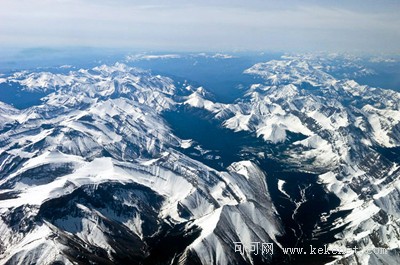(单词翻译:单击)
听力原文
昨天咱们去了趟实验室,知道了铁元素重要的作用。今天,我们要来设想一下,这么大的落基山脉究竟是如何形成的?你想知道科学家经过实地调查研究,给出了一个什么样的解释?听听吧!
It's now at the surface. How did it get here? It's been pushed up by the rise of the Rocky Mountains and in doing so, look what it has done on the Flatiron.
Scientists investigating the Rocky Mountains have found two clues about their early history. Ammonites, on the side 8000 feet high, are evidence that the area was once under the sea. Traces of iron in granite is evidence that rock, pushed up from 15 miles below the surface, tilting the Flatirons. And it didn't just happen here, but along approximately a thousand miles of the American Rockies. Geologists now needed to find out what monumental forces were responsible for this massive upheaval.
One hundred million years ago, most of North America was covered by a vast inland sea. 70 million years ago, the sea retreated. And the Rocky Mountains began to rise, forming a great mountain range. Scientists trying to piece together their geological past, needed to solve the mystery of what lifted them up.
A force capable of that amount of heavy lifting would have to have been on a global scale. Geologists believe this force was caused by plate tectonics. The earth's crust is broken up into a series of interlocking plates. These plates are continuously on the move. Over millions of years, they collide and break apart, forming new continents and geological features around the world. When the Rockies formed, two of these plates smashed into each other at the American west coast.
What we know is that at the time of this grand uplift, on the western margin of North America, ocean crust, and Oceanic Plate, was subducting beneath the North American Plate. And it was doing so at a high rate of speed. As such, it was transferring stress into the interior of the continent.
As the two plates move towards each other, they squeeze the crust. Over millions of years, it folded and buckled, forming tall mountains. This was the birth of the American Rockies. But a mystery …
小编有约:"Geologists believe this force was caused by plate tectonics. " Daisy想知道,地质学家给的这个假设,你觉得怎样?所以Daisy今天的问题就是要问问大家,你了解板块构造论吗?
听力答案
板块构造说是20世纪60年代提出的一种新的全球构造学说。板块构造说的理论是在大陆漂移学说、海底扩张学说的基础上发展起来的。1912年,德国气象学家A.魏格纳(1880—1930)在总结前人有关大陆漂移概念的基础上,提出一种大地构造假说——大陆漂移说,引起全世界科学界的重视。第二次世界大战后,由于科学技术的发展,各国展开了多方面的海洋调查工作,并获得了大量海洋科学的资料。例如,发现或进一步弄清了大洋中脊形态、海底地热流分布异常、海底地磁条带异常、海底地震带及震源分布、岛弧及与其伴生的深海沟、海底年龄及其对称分布、地幔上部的软流圈等等。在这些新资料的基础上,产生了一个崭新的学说——海底扩张说。 这些是板块构造说的理论基础。小编在百度百科中找到的内容,如果想知道详情,就自己动手查一查资料,这样更有意义。Daisy一直觉得地理是非常有意思的学科哦。
参考译文
它们是如何来到岩石的表面?这是由于落基山脉的崛起,同时也就把它们带到了表面,就像现在的平顶脊(熨斗形岩石)一样。
调查落基山脉的科学家已经发现两条关于它的历史。菊石化石在8000英尺高的山上,有力的证明该地区曾经在海下。花岗岩中的铁元素向我们证明,岩石是从地表下的15公里升起来的,同时形成了平顶脊(熨斗形岩石)。也不仅仅只发生在这里,沿途一千英里的美国落基山脉几乎都是这种情况。地质学家们现在需要找出究竟是一股什么巨大的力量能够从海中隆起这落基山脉。
一亿年前,北美大部分是无边无际的内陆海。7000万年前,海水隐退。落基山脉慢慢开始升起,直到最后形成了巨大的山脉。科学家试图弄情况它们的地质历史,这样就揭开了它们升起来的神秘面纱。能够使落基山脉升起的巨大力量,可能是一场全球范围的变动导致的。地质学家认为,这股力量是由地球板块构造引起的。地壳被分解成为一系列环环相扣的板块。这些板块在不断地移动。过了数百万年,他们在一起经历了碰撞和分离,形成了新的大陆。全世界从此具有了新的地质特征。当落基山脉形成后,其中有两个板块的剧烈冲击使它们在一起,同时屹立于美国的西海岸。
我们所知道的是,这段时间内在北美的西部边缘地带,海洋地壳,以及海洋板块,从北美板块下大面积地隆起。一切都是这样高速的运行。因此,就会转移压力到大陆的内部。
由于这两个板块都朝对方移动,所以他们相互挤压地壳。经过数百万年的时间,它们折叠相扣在一起,终形成高山群。美国落基山脉就此诞生。但是仍有谜团存在......
在今天翻译的过程中,Daisy花了些时间的句子,我会在后面的句子讲解部分展示出来,这里Daisy想把它讲解出来给大家看一看,觉得Daisy这样的理解,是否合适?Daisy等着大家的留言哦。
重点讲解
注释:① push vt. 推动;增加;推行;逼迫
vi. 推;推进;增加;伸展;努力争取
n. 推;决心;奋力;攻击;干劲;进取心
例句:
1. Some plants push their roots deep into the soil.
一些植物的根深深长入土中。
2. It's not my job to push up the sales.
我并不负责提高销售额。
② investigate v. 调查;研究
例句:
1. However, as evidence began to accumulate, experts felt obliged to investigate.
然而,由于证据开始增多了,专家们感到必须进行调查了。
2. The climbers sent two men up to investigate the rockfall.
登山者派了两个人爬上去察看岩石坠落的情况。
③ subduct vt. 除去;减去;取回
vi. 下拉;撤去 vt. 除去;减去;取回
例句:
1. The border between the North American and Eurasian Plates does not subduct.
北美板块和欧亚板块之间的边界地区不会俯冲潜没,也不会滑动。
句子讲解:
1.Traces of iron in granite is evidence that rock, pushed up from 15 miles below the surface, tilting the Flatirons.
【结构简析】咋一看,咦,怎么有三个动词在句子中。其实,后面的两个是非谓语动词,"pushed" 和"tilting"中首先讲讲"pushed",它是过去分词,用来解释说明"rock"从哪里来。"tilting"是现在分词,做伴随状态,岩石升上来的同时也就倾斜成烫斗状。
【参考译文】花岗岩中的铁元素向我们证明,岩石是从地表下的15公里升起来的,同时倾斜成了平顶脊(熨斗形岩石)。
2. What we know is that at the time of this grand uplift, on the western margin of North America, ocean crust, and Oceanic Plate, was subducting beneath the North American Plate.
【结构简析】这是一个由what引导的主语从句,后面接着"that"的表语从句。句子中插入的部分太多,导致Daisy刚开始理解错了.后来,多看几遍后,知道了原来"and"的理解非常关键,它不是 "on the western margin of North America, ocean crust, and Oceanic Plate"整个的作为插入语,而是" ocean crust, and Oceanic Plate, was subducting beneath the North American Plate. "。
【参考译文】我们所知道的是,这段时间内在北美的西部边缘地带,海洋地壳,以及海洋板块,从北美板块下大面积地隆起。


